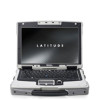Dell Latitude D630 XFR Quick Reference Guide - Page 21
Dell Diagnostics - review
 |
View all Dell Latitude D630 XFR manuals
Add to My Manuals
Save this manual to your list of manuals |
Page 21 highlights
INFORMATION - · Ensure that the program is compatible with the operating system installed on your computer Ensure that your computer meets the minimum hardware requirements needed to run the software. See the software documentation for information Ensure that the program is installed and configured properly Verify that the device drivers do not conflict with the program If necessary, uninstall and then reinstall the program. BACK UP YOUR FILES IMMEDIATELY. USE A VIRUS-SCANNING PROGRAM TO CHECK THE HARD DRIVE, FLOPPY DISKS, OR CDs. SAVE AND CLOSE ANY OPEN FILES OR PROGRAMS AND SHUT DOWN YOUR COMPUTER THROUGH THE START MENU. SCAN THE COMPUTER FOR SPYWARE - If you are experiencing slow computer performance, you frequently receive popup advertisements, or you are having problems connecting to the Internet, your computer might be infected with spyware. Use an anti-virus program that includes anti-spyware protection (your program may require an upgrade) to scan the computer and remove spyware. RUN THE DELL DIAGNOSTICS - See "Dell Diagnostics". If all tests run successfully, the error condition is related to a software problem. 6.2 Dell Diagnostics CAUTION: Before you begin any of the procedures in this section, follow the Safety Information in the XFR630 with Touch Fully Rugged Notebook User's Guide. 6.2.1 When to Use the Dell Diagnostics If you experience a problem with your computer, perform the checks in "Lockups and Software Problems" and run the Dell Diagnostics before you contact Dell for technical assistance. It is recommended that you print these procedures before you begin. NOTICE: The Dell Diagnostics work only on Dell™ computers. NOTE: The Drivers and Utilities CD is optional and may not ship with your computer. See "System Setup Program" in your XFR630 with Touch Fully Rugged Notebook User's Guide to review your computer's configuration information, and ensure that the device you want to test displays in system setup and is active. Start the Dell Diagnostics from either your hard drive or from the optional Drivers and Utilities CD. 6.2.2 Starting the Dell Diagnostics From Your Hard Drive The Dell Diagnostics is located on a hidden diagnostic utility partition on your hard drive. NOTE: If your computer does not display a screen image, contact Dell. NOTE: If the computer is connected to a docking device (docked), undock it. See the documentation that came with your docking device for instructions. 1. Ensure that the computer is connected to an electrical outlet that is known to be working properly. 2. Turn on (or restart) your computer. 3. Start the Dell Diagnostics in one of the following two ways: NOTE: If you wait too long and the operating system logo appears, continue to wait until you see the Microsoft® Windows® desktop; then shut down your computer and try again. 1. When the DELL™ logo appears, press immediately. Select Diagnostics from the boot menu and press . NOTE: Before attempting option 'b', the computer must be powered down completely.












